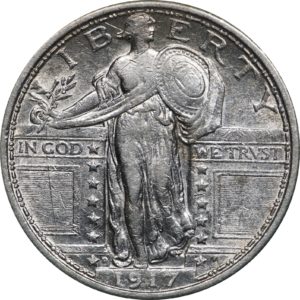Standing Liberty Quarter (1916-1930)
In 1916, the atmosphere in the United States of America was tense, to say the least. WWI was raging fiercely and the country was in a politically charged state. As such, the federal government was highly interested in a coin that stood for the increased desire for national self-interest and protection. Ultimately, they decided to mint such a coin to embody this desire in the public consciousness. This lead to the beginning of the Standing Liberty Quarter. The government held a competition to choose the design for the Quarter, the common way to select Quarter designs by that point.  Hermon Atkins MacNeil was chosen to create the design for the coin. MacNeil was known for his earlier works which depicted Americans and Native Americans, often on public monuments.
Hermon Atkins MacNeil was chosen to create the design for the coin. MacNeil was known for his earlier works which depicted Americans and Native Americans, often on public monuments.
Taking inspiration from Ancient Greek artwork, MacNeil depicted and standing Liberty who was facing frontward. This Liberty also bears a shield and is standing in a defensive pose. On the top of the design is the word ‘LIBERTY’, while the date is shown below. To the side of Liberty is the phrase ‘IN GOD WE TRUST’. On the reverse side of the coin is the classic American eagle, this time in active flight. Above the eagle are the standard phrases ‘UNITED STATES OF AMERICA’ and ‘E PLURIBUS UNUM’, while below it is the denomination for the coin.
The Standing Liberty Quarter is extremely popular with modern collectors due to its widely-renowned and beautiful design. Typically, collectors will put together the a set by date and mint combination. While it’s impossible with most coins to collect a full set in uncirculated condition, this is not the case with the Standing Liberty series, where is is still possible (though spectacularly difficult) to do so.
The most widely desired date for the series is 1916, which had the fewest number of mintings. This is something of a relative interest however, as even this variation of the Quarter has many surviving coins. Additional dates that many collectors find difficult to find include 1920, 1926, and 1927. On the flip side, some of the easier years of this series to find in gem condition include 1917 and 1930, where is not completely infrequent to encounter gem variations. While it is possible to find other years in gem condition, those two are the best bet for collectors and thus tend to be the most sought after.
There are several key factors to look at for those grading this design. On the obverse, the parts you’d want to look the most closely at include Liberty’s right knee and her shield’s center. Spots to look at on the reverse side for wear are the eagle’s breast and left wing. One important thing to keep in mind when checking this coin is to see if it meets the criteria for a full strike. Those criteria are Liberty’s hair being fully visible, a complete hairline on Liberty’s brow, and visible ear indentation. If a coin of this series is fully struck, it will fetch a far higher price among collectors than if it were not.
